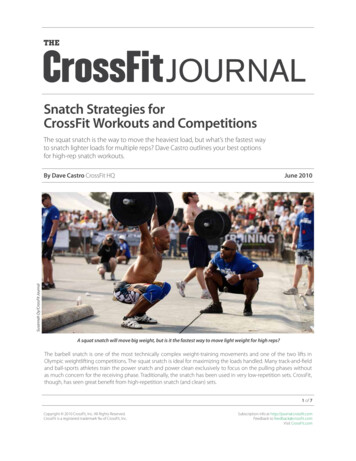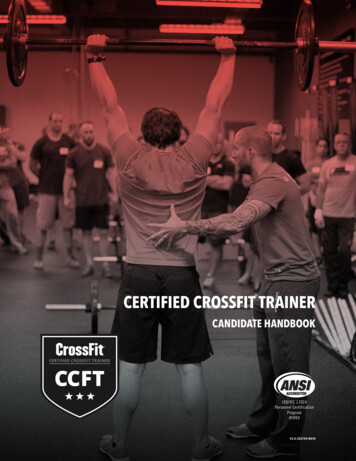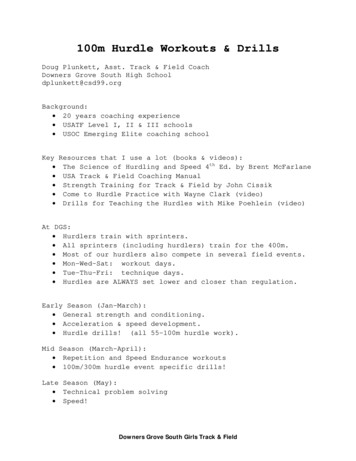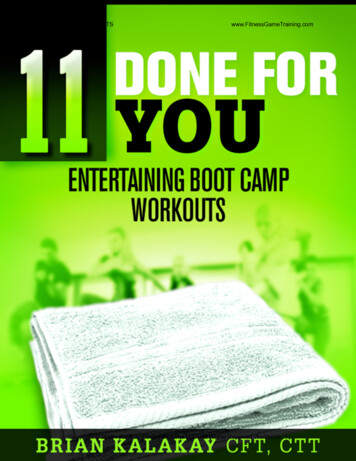
Transcription
Snatch Strategies forCrossFit Workouts and CompetitionsThe squat snatch is the way to move the heaviest load, but what’s the fastest wayto snatch lighter loads for multiple reps? Dave Castro outlines your best optionsfor high-rep snatch workouts.June 2010Susannah Dy/CrossFit JournalBy Dave Castro CrossFit HQA squat snatch will move big weight, but is it the fastest way to move light weight for high reps?The barbell snatch is one of the most technically complex weight-training movements and one of the two lifts inOlympic weightlifting competitions. The squat snatch is ideal for maximizing the loads handled. Many track-and-fieldand ball-sports athletes train the power snatch and power clean exclusively to focus on the pulling phases withoutas much concern for the receiving phase. Traditionally, the snatch has been used in very low-repetition sets. CrossFit,though, has seen great benefit from high-repetition snatch (and clean) sets.1 of 7Copyright 2010 CrossFit, Inc. All Rights Reserved.CrossFit is a registered trademark ‰ of CrossFit, Inc.Subscription info at http://journal.crossfit.comFeedback to feedback@crossfit.comVisit CrossFit.com
Snatch .(continued)The goal of CrossFit is to develop increased work capacityacross broad time and modal domains, and athletes withgreat capacity in high-repetition snatches and cleans havedemonstrated broad capacity generally. In other words,these movements are outstanding for transferring abilitiesto other domains.1 Rep or 30 Reps?The traditional approach to the Oly lifts is to use thesemovements to develop explosive speed and power. Theyhave certainly been proven effective for that purpose, andthe best results are found with shorter sets. CrossFittersare certainly interested in explosive power and speedand will train low-rep Oly lifts. But true general physicalpreparedness (GPP) requires that we not pursue them tothe exclusion of the other domains of fitness. Includinghigh-rep snatch (and clean) workouts has a broader aimthan training only power and speed.The question now is what is the best way to maximizethe number of reps performed in a given time period (orminimize the time to perform a fixed number of reps)?The question now is what isthe best way to maximize thenumber of reps performed ina given time period?Susannah Dy/CrossFit JournalMuch attention has been paid to the technique of thesnatch, and good technique is essential to maximizing theloads moved in any given set. If the barbell moves outsidethe base of support, the body’s positioning is suboptimaland lifts are often missed. If the lifter doesn’t maximize fulluse of the hips, the lifts will not be successful. CrossFitterswill do well to develop this technique as much as isreasonable for their 1RM efforts.The same approach, though, is not necessarily neededwhen dealing with light loads. These lifts can be successfuleven with inefficient technique, including keeping the hipshigh, pulling with the arms, not coming to full extensionon the second pull and even swinging the barbell out.When speed is the goal, athletes can benefit by experimenting with their technique to produce the fastest cycle time.2 of 7Copyright 2010 CrossFit, Inc. All Rights Reserved.CrossFit is a registered trademark ‰ of CrossFit, Inc.Subscription info at http://journal.crossfit.comFeedback to feedback@crossfit.comVisit CrossFit.com
Snatch .(continued)It is often thought that optimal technique for 1RM workand high-rep work is identical. After all, it comes downto physics, right? Well, maybe not, or perhaps it’s moreaccurate to say that maybe the physics are different atlight loads. In CrossFit competitions, we are not seeinga strong correlation between the completion times forhigh-rep snatch and clean workouts and the efficient useof traditional techniques. Some of the fastest times comewith “great technique,” but many do not.What does this mean for us?Well, as fitness whores and not technique snobs, thismeans we should explore non-traditional techniques forhigh-rep workouts.Squat SnatchWhen doing high-rep snatches, we also see differentoptions for attacking these workouts, which typicallyfeature loads lighter than a person’s 1RM snatch. This articleis not about teaching someone how to do the lift. It’s aboutgiving the athlete who wants to be more efficient differentthings to think about with regards to attacking a high-repsnatch workout.We’ll start with the squat snatch. For establishing your 1RMsnatch, the squat snatch is the most efficient movement.It is arguably also one of the most technically challengingmovements we do with a barbell. The stance is aboutshoulder width, with the chest high. The grip is wide.Lumbar curve is maintained as the athlete passes througha positioning pull and comes to full extension, all thewhile creating speed and elevation on the bar. The athletethen rapidly changes direction to receive the bar in anoverhead-squat position. You can spend a lifetime trainingthis movement and never perfect it, but that alone is noreason to avoid putting this article down right now andtrying a few reps with a broomstick in your garage. Trainthe squat snatch regularly, and don’t be afraid to look like abeginner in this movement.Heavy squat snatch: .wmvPrescription of Movementin High-Rep CrossFit WODs 30 135-lb. squat snatches for time.75 75-lb. power snatches for time.5 rounds of 7 hang power snatches (135 lb.) and 15pull-ups.Susannah Dy/CrossFit JournalThe preceding workouts should be done exactly as written.(Scale load when necessary and for trainees who haveflexibility issues or are new to the lift. Scale movementswhen necessary as well.) It’s part of what you, your coachor the workout of the day wants you to work on regardlessof load and ability. Athletes can receive tremendousphysical and psychological rewards for grinding throughthe movement and doing what is prescribed, and 30 squatsnatches at 135 lb. is a demanding feat for even the bestCrossFitters.At the 2009 CrossFit Games, Jason Khalipa did very well withboth heavy snatches and light snatches. At light weight, hechose to use a muscle snatch and then an overhead squatto complete his reps at 75. lb. Isabel — 30 snatches for time (135 lb.).Randy — 75 snatches for time (75 lb.).WOD — 5 rounds of 7 hang snatches (135 lb.) and 15pull-ups.3 of 7Copyright 2010 CrossFit, Inc. All Rights Reserved.CrossFit is a registered trademark ‰ of CrossFit, Inc.Subscription info at http://journal.crossfit.comFeedback to feedback@crossfit.comVisit CrossFit.com
Snatch .(continued)These high-rep workouts give the athlete some options inhow he chooses to do the snatch. Here is where we canget creative and decide on a pre-workout strategy to getthe work done as fast as possible.Coach Mike Burgener likes tosay a squat snatch is simply amissed power snatch.In a workout like Isabel, athletes will either squat-snatchor power-snatch the weight, though a few of our strongerathletes can actually muscle-snatch 135 lb. The powersnatch starts with a similar start to the squat snatch, butinstead of receiving the weight in a squat position, youreceive it in a partial squat with your feet at shoulderwidth. We do not quantify the depth of this squat becauseit varies for each athlete and according to load. Coach MikeBurgener likes to say a squat snatch is simply a missedpower snatch.Power SnatchFor a high-rep snatch workout with a traditional powersnatch approach, we end up seeing feet starting at hipwidth and landing at shoulder width. The athlete thenstands to full extension and resets the feet as (or after) heor she brings the weight down. Once the bar is on theground, the athlete repeats the process. If an athlete isvery strong with this movement this can be unnecessarilytime consuming. In the video below, both Josh Everett andAdrian Bozman move their feet to the landing position,then reset them to the pulling position while the baris overhead.High-speed power-snatch reps: .mov .wmvAnother aspect we see with high-rep snatches is ahigher hip position throughout the movement, with theshoulders more aggressively over the bar. This allows theathlete to save some time by not resetting each time intothe low-butt, high-chest position that is common withheavy snatches. From this traditional power snatch, wecan start tweaking it and working on different techniquesand strategies that can be used to shave seconds fromWOD times.Muscle SnatchIn workouts that have light snatches (relative to strength),it might be best to employ muscle snatches. In the musclesnatch you still create speed on the bar, but instead ofre-dipping as you would in a power or squat snatch, yourknees and hips do not close again after extension. Themuscle snatch requires more upper-body strength and istypically done as a skill-transfer exercise for weightlifters.The other key aspect of high-rep muscle snatches is nevermoving your feet away from their starting position, usuallyhip width. Remaining stationary will allow you to cyclethe reps in the fastest way possible. Depending on therep scheme and load, the muscle snatch is also one of themost taxing ways to do this movement. Trying to maintaina fast pace for very high-rep workouts might not be worththe toll it takes on your system for later reps.Muscle snatch: .mov .wmvHigh-rep muscle snatch: .mov .wmvAt the 2009 Rocky Mountain Regional Skip Miller organized,he programmed a workout that required a total of 7,000 lb.to be snatched overhead, while the loads were left up tothe athletes. Matt Chan chose 75 lb. and muscle-snatchedthe weight to a hard-earned victory. He muscle-snatchedroughly 50 of the reps before having to switch to a moretraditional power snatch. The muscle-snatch rep wasmuch faster than the traditional power-snatch rep.Matt Chan muscle-snatching: .mov .wmv4 of 7Copyright 2010 CrossFit, Inc. All Rights Reserved.CrossFit is a registered trademark ‰ of CrossFit, Inc.Subscription info at http://journal.crossfit.comFeedback to feedback@crossfit.comVisit CrossFit.com
Snatch .(continued)Muscle Snatch to Power SnatchIt’s also good to be able to switch from the musclesnatch to the stationary power snatch, just as Chan didin regional competition. Being able to recognize you’relosing the muscle snatch and knowing when to transitionto the power snatch can be key to moving through thereps quickly.I did this workout with Greg Amundson at the track a fewmonths back:5 rounds of:15 power snatches (95 lb.)Run 400 metersPower Snatch With No Adjustment of FeetHigh-rep muscle snatches at some point usually morphinto something like a power snatch, where the athletere-dips to catch the load. The difference here—and thisis the difference that makes it more efficient—is that thefeet do not change position; i.e. the pulling position andthe receiving position are the same. This approach is fasterthan a traditional power snatch because it eliminates resettime, but it’s slower than the muscle snatch. The powersnatch with stationary feet is less taxing than the musclesnatch and might be better for long-term use in a workout.Prior to the workout, I spoke to Greg about some of thedifferent ways to do the work, and he decided to experiment. He was constantly in front of me, so I was able towatch him muscle-snatch most of the reps in the earlyrounds, and then at reps 10 and above on the later rounds,he transitioned to a power snatch.Muscle snatch transition to power snatch: .mov .wmvHigh-rep snatches with fixed feet: .mov .wmvBeing able to recognizeyou’re losing the musclesnatch and knowing whento transition to the powersnatch can be key tomoving through thereps quickly.At the 2009 Rocky Mountain Regional, Matt Chan employeda blisteringly fast muscle snatch before pounding out thelatter reps with a power snatch.5 of 7Copyright 2010 CrossFit, Inc. All Rights Reserved.CrossFit is a registered trademark ‰ of CrossFit, Inc.Subscription info at http://journal.crossfit.comFeedback to feedback@crossfit.comVisit CrossFit.com
Snatch .(continued)Traditional Power snatchWeight Is Overhead—Now What?Once the weight begins to get to a point where theabove-listed options are not possible, it’s time to look ata more traditional power snatch, where the feet start atabout shoulder width and but land wider as the weight isreceived in a partial squat. The athlete stands to completethe movement and resets the feet before starting thenext pull. I have also seen this done where the feet startin a landing position (wider) and stay in that positionthroughout.Once the weight is locked out overhead and the athleteis standing, he or she has several options in returning theweight to the ground for the next rep.Traditional power snatch: .mov .wmvPower snatch from wide pulling positions(fixed stance): .mov .wmvSplit SnatchAfter the power snatch goes on heavier high-repworkouts, another option is to switch to a split snatch. Asplit snatch requires more skill than just a power snatchbut is less difficult for most people than moving to the fullsquat snatch on high-rep workouts. One downside to thismovement is the need to reset the feet after each rep. Thelength and subsequent depth of the split will increase asthe weight nears an athlete’s 1RM. The heavier the load,the deeper you go.Split snatch: .mov .wmvPulling It DownFor fastest turnover of reps with light loads, bringing theweight straight down from an overhead position is thefastest way. The weight hits the overhead position and youessentially pull it back to the bottom while maintainingyour grip on the bar throughout. This is very demandingbecause it allows little time for relaxing or breathing. Thismethod is best used with a fast move like the musclesnatch or power snatch with no adjustment of feet. If youare going to squat snatch or split snatch, you might wantto look at some of the other options.Pulling weight down: .mov .wmvDown to Hips and ResetA technique that’s slower than the previous methodwould be bringing the weight down to the hang position
for high-rep snatch workouts. The barbell snatch is one of the most technically complex weight-training movements and one of the two lifts in Olympic weightlifting competitions. The squat snatch is ideal for maximizing the loads handled. Many track-and-field and ball-sports athletes train the power snatch and power clean exclusively to focus on the pulling phases without as much concern for .











